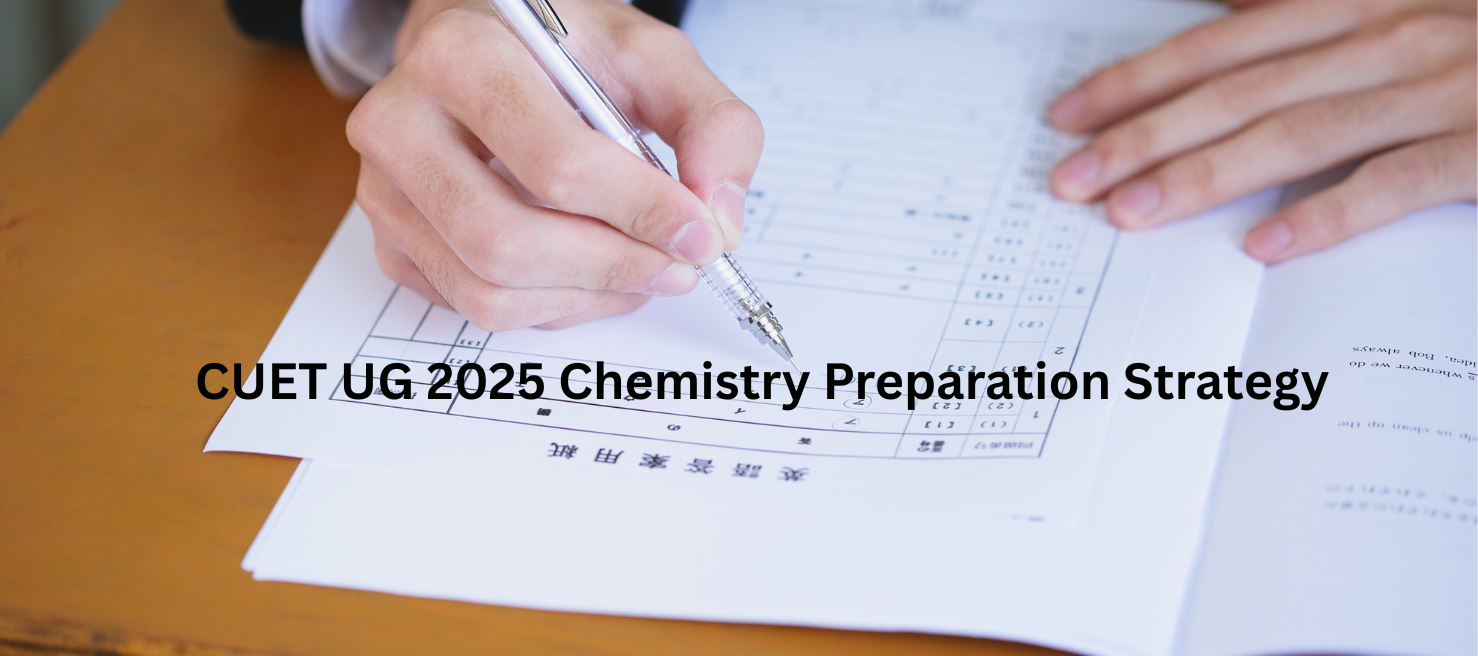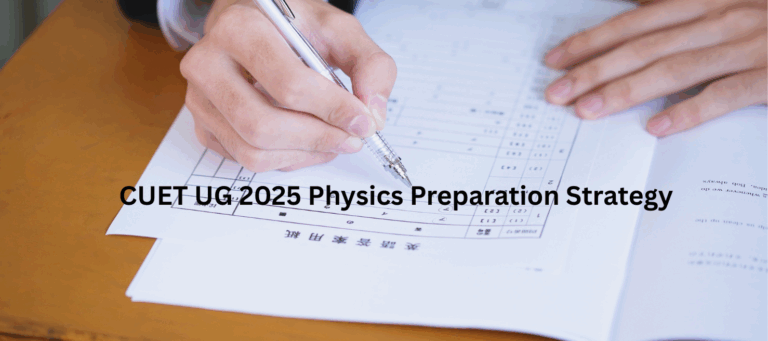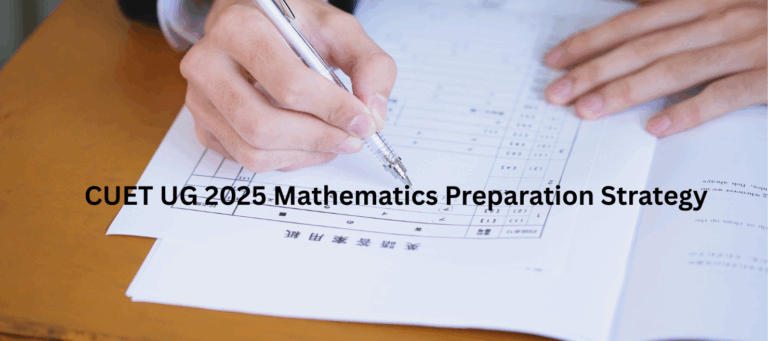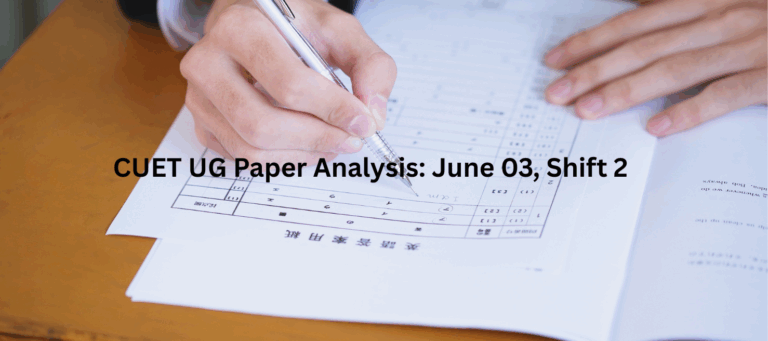
The CUET UG 2025 exam, conducted by the National Testing Agency annually, is a national-level examination. The CUET exam is held for entrance into undergraduate courses across several state, central and private universities in India. Over 10 lakh candidates appear for the exam every year, making it one of the most popular entrance examinations for various undergraduate courses. The CUET exam for 2025 is scheduled from May 13th to June 3rd. Students can check the exam analysis articles here on our official website, i.e. collegedost.in.
Candidates have to go through several processes, like the CUET UG 2025 exam preparation, counselling, and admission process. While the CUET exam preparation can feel hectic, following the right preparation strategy, understanding the CUET exam syllabus, and attempting mock tests can help you seamlessly tackle the exam and score high. Candidates can refer to the official website for the subject-wise preparation strategy and CUET exam preparation tips.
Understanding the CUET Exam Pattern
The CUET exam pattern is curated to test the candidate’s abilities in three major areas, like their language, aptitude and subject knowledge. Candidates have to complete the exam in 60 minutes(For each subject). Here’s the detailed CUET exam pattern:
| Section | Duration of the Exam | Questions Type | No of Questions |
| Section IA- Language | 60 Minutes for Each Subject | Reading Comprehension. VocabularyGrammar | 50 Questions |
| Section II- Domain Specific | Subject-specific questions. | 50 Questions | |
| Section III- General Test | General Awareness Reasoning Aptitude | 50 Questions |
PYQS of The CUET Chemistry Subject
Previous years’ question papers are an essential source of exam preparation. Students can get insights like the difficulty level of the questions, the most frequently asked topics, and the amount of preparation required to tackle the CUET UG 2025 exam. Download the CUET Chemistry question papers here:
| CUET UG Chemistry Previous Year’s Question Papers | ||
| Date/Year | Question Paper | Solution |
| 2022: CUET Chemistry | Download here | Download here |
| 2023 CUET Chemistry | Download here | Download here |
| 2024 CUET Chemistry | Download here | Download here |
| 2025 CUET Chemistry | Download here | Download here |
CUET Syllabus 2025 for Chemistry Subject
It is important to understand the CUET Syllabus for science students, for each subject, to understand the types of questions asked and the amount of preparation you require to tackle the questions in the exam. Understanding the CUET syllabus also helps you strategise your exam to comprehensively cover the complete CUET syllabus and score high in the exam. Check the CUET syllabus for science students below:
CUET Chemistry Syllabus 2025
Check the CUET syllabus for the Chemistry subject here:
| Unit | Syllabus |
| Unit I: Solutions | Types of solutions, expression of concentration of solutions of solids in liquids, solubility of gases in liquids, solid solutions, Raoult’s law, colligative properties such as relative lowering of vapour pressure, elevation of boiling point, depression of freezing point, and osmotic pressure. Determination of molecular masses using colligative properties, abnormal molecular mass, and Van’t Hoff factor. |
| Unit II: Electrochemistry | Redox reactions, EMF of a cell, standard electrode potential, Nernst equation and its application to chemical cells, relation between Gibbs energy change and EMF of a cell. Conductance in electrolytic solutions, specific and molar conductivity, variations of conductivity with concentration, Kohlrausch’s law, electrolysis and law of electrolysis (elementary idea), dry cell, electrolytic cells and Galvanic cells, lead accumulator, fuel cells, and corrosion. |
| Unit III: Chemical Kinetics | Rate of a reaction (average and instantaneous), factors affecting rate of reaction including concentration, temperature and catalyst, order and molecularity of a reaction, rate law and specific rate constant. Integrated rate equations and half-life for zero and first order reactions, concept of collision theory (elementary idea without mathematical treatment), activation energy and Arrhenius equation. |
| Unit IV: d and f Block Elements | General introduction, electronic configuration, occurrence and characteristics of transition metals, general trends in properties of the first row transition metals including metallic character, ionization enthalpy, oxidation states, ionic radii, colour, catalytic property, magnetic properties, interstitial compounds, and alloy formation. Preparation and properties of potassium dichromate (K₂Cr₂O₇) and potassium permanganate (KMnO₄). Lanthanoids including electronic configuration, oxidation states, chemical reactivity, lanthanoid contraction and its consequences. Actinoids including electronic configuration, oxidation states, and comparison with lanthanoids. |
| Unit V: Coordination Compounds | Coordination compounds including introduction, ligands, coordination number, colour, magnetic properties and shapes, IUPAC nomenclature of mononuclear coordination compounds. Bonding theories including Werner’s theory, Valence Bond Theory (VBT), and Crystal Field Theory (CFT). Structure and stereoisomerism, and the importance of coordination compounds in qualitative analysis, extraction of metals and biological systems. |
| Unit VI: Haloalkanes and Haloarenes | Nomenclature, nature of carbon–halogen (C–X) bond, physical and chemical properties, and optical rotation. Mechanism of substitution reactions in haloalkanes. In haloarenes, nature of the C–X bond and substitution reactions with directive influence of halogen in monosubstituted compounds. Uses and environmental effects of compounds like dichloromethane, trichloromethane, tetrachloromethane, iodoform, freons, and DDT. |
| Unit VII: Alcohols, Phenols and Ethers | Alcohols including nomenclature, methods of preparation, physical and chemical properties (of primary alcohols only), identification of primary, secondary and tertiary alcohols, mechanism of dehydration, and uses with special reference to methanol and ethanol. Phenols including nomenclature, methods of preparation, physical and chemical properties, acidic nature, electrophilic substitution reactions and uses. Ethers including nomenclature, methods of preparation, physical and chemical properties and uses. |
| Unit VIII: Aldehydes, Ketones and Carboxylic Acids | Aldehydes and ketones including nomenclature, nature of the carbonyl group, methods of preparation, physical and chemical properties, mechanism of nucleophilic addition, reactivity of alpha hydrogen in aldehydes, and uses. Carboxylic acids including nomenclature, acidic nature, methods of preparation, physical and chemical properties, and uses. |
| Unit IX: Amines | Amines including nomenclature, classification, structure, methods of preparation, physical and chemical properties, uses, and identification of primary, secondary and tertiary amines. Diazonium salts including preparation, chemical reactions, and importance in synthetic organic chemistry. |
| Unit X: Biomolecules | Carbohydrates including classification into aldoses and ketoses, monosaccharides such as glucose and fructose, D-L configuration, oligosaccharides such as sucrose, lactose, and maltose, polysaccharides such as starch, cellulose and glycogen, and the importance of carbohydrates. Proteins including elementary ideas of amino acids, peptide bond, polypeptides, proteins, and the primary, secondary, tertiary and quaternary structures of proteins (qualitative idea only), denaturation of proteins, and enzymes. Hormones including elementary ideas (excluding structure), vitamins including classification and functions. Nucleic acids including DNA and RNA. |
CUET UG 2025 Chemistry Important Topics
Focusing on the Important topics can yield the desired results instead of wasting a lot of time on the topics that are not often asked in the exam. Here are some important topics that are often asked in the CUET exam:
Chemistry
Chemistry is one of the important subjects that most candidates choose to appear for. Here are the important topics for CUET 2025 Chemistry:
| Unit | Important Topics(Number of Questions) |
| Organic Chemistry | Alcohol, Phenol, and Ether(3-4) Aldehyde, Ketone, and Carboxylic Acid(4-5) Haloalkane and Haloarene(3-4) Polymer(1-2) Amine(3-5) Biomolecules(2-3) Chemistry in Everyday life(1-2) |
| Inorganic Chemistry | P-Block(4-5) D-Block(2-3) Coordination components(3-4) Metullurgy(1-2) |
| Physical Chemistry | Electro Chemistry(2-3) Surface Chemistry(4-5) Chemical Kinetics(3-4) Solutions(2-3) Solid state(2-3) |
CUET UG 2025: 60-Day Preparation Plan for Chemistry
It is important to cover the syllabus comprehensively in order to score high in the CUET Chemistry exam. Here we have given you a detailed 60-day preparation plan for the Chemistry syllabus to help you with your preparation.
| Week | Topics to Cover | Focus Areas & Tasks |
| Week 1 | Unit I: Solutions | Understand types of solutions, concentration terms, Raoult’s Law; study colligative properties; practice van’t Hoff factor problems; solve NCERT & PYQs |
| Week 2 | Unit II: Electrochemistry (Part 1) | Cover redox reactions, EMF, standard electrode potential; derive and apply the Nernst equation; relate Gibbs energy to EMF; solve conceptual questions |
| Week 3 | Unit II: Electrochemistry (Part 2) | Learn conductivity types, Kohlrausch’s Law, electrolytic & galvanic cells, fuel cells, corrosion; revise diagrams & numericals; attempt PYQs |
| Week 4 | Unit III: Chemical Kinetics | Understand rate laws, order, molecularity, integrated rate equations (0 & 1st order), Arrhenius equation; practice numericals and graphs |
| Week 5 | Unit IV: d- & f-Block Elements | Focus on trends in transition elements, properties of KMnO₄ & K₂Cr₂O₇, lanthanoid contraction, differences with actinoids; revise NCERT tables |
| Week 6 | Unit V: Coordination Compounds | Cover ligand types, IUPAC naming, bonding theories (Werner, VBT, CFT), isomerism, uses in biology & metallurgy; solve NCERT & past papers |
| Week 7 | Unit VI: Haloalkanes & Haloarenes | Study nomenclature, C–X bond, SN1/SN2 mechanisms, reactions of haloarenes, environmental effects of organohalogens; revise mechanisms |
| Week 8 | Unit VII: Alcohols, Phenols, Ethers | Learn preparation, reactions & uses of alcohols, phenols, and ethers; understand acidic nature & dehydration mechanism; practice classification |
| Week 9 | Unit VIII & IX: Aldehydes, Ketones, Carboxylic Acids + Amines | Study carbonyl reactions, nucleophilic addition, alpha-H reactivity, amine classification, preparation, diazonium salts; revise functional group reactions |
| Week 10 | Unit X: Biomolecules + Full Syllabus Revision | Revise carbohydrates, proteins, enzymes, vitamins, DNA/RNA; spend 4 days on full syllabus test, NCERT summary, PYQs & mock tests |
CUET UG 2025 Booklist for Chemistry
Referring to the best sources is important to help you understand the concepts better, and helps you solve the numerical problems better. It is important to choose the resource that maintains a fine balance between theory and practical application. Here are some important resources for the CUET chemistry subject:
| Book Title | Author / Publisher | Purpose |
| NCERT Class 12 Textbook for Chemistry | NCERT | Core textbook; essential for concept clarity & board prep |
| NCERT Exemplar for Chemistry | NCERT | Advanced conceptual questions; useful for JEE/NEET practice |
| Handbook of Chemistry | Arihant | Quick revision; formulas, reactions & important summaries |
| Chemistry for Competitive Exams | Shriniwas Gurjar | Objective questions: great for JEE/NEET-level practice |
| Dinesh Chemistry Guide | Dinesh Publications | Detailed theory + MCQs; comprehensive support for boards |
| Organic Chemistry Objective | Arihant | Objective problems in Organic Chemistry for entrance exams |
| Modern’s ABC of Chemistry for Class 12 | Modern Publishers | In-depth explanation + diagrams; useful for both board & JEE |
| Physical Chemistry | O.P. Tandon | Strong theoretical base + numerical practice (Physical Chemistry) |
CUET UG 2025 Chemistry Preparation Tips
Following some important tips can save students a lot of time while enhancing their preparation. Here are some of the tips to help you prepare effectively for the CUET UG 2025 exam:
| Tip | Strategy | Why It Matters |
| Start with NCERT | Thoroughly read Class 12 NCERT line by line | CUET questions are mostly NCERT-based; it ensures conceptual clarity |
| Master Physical Chemistry formulas | Maintain a formula sheet for Solutions, Electrochemistry, and Kinetics | Direct formula-based questions are frequent in CUET |
| Focus on Mechanisms in Organic | Understand reaction mechanisms in Haloalkanes, Alcohols, Aldehydes, Amines | CUET tests conceptual understanding over memorisation in organic chemistry |
| Use NCERT diagrams and tables | Revise structures, trends, and comparison tables from the NCERT | Visual-based MCQs and reasoning-based questions are common |
| Revise Coordination Chemistry thoroughly | Practice IUPAC naming, bonding theories, and isomerism | Frequently asked due to structured and predictable question types |
| Attempt topic-wise PYQs | Solve past CUET and Board-type MCQs after finishing each unit | Reinforces recall, highlights common traps in questions |
| Weekly mock tests | Take CUET-style full Chemistry section mocks every week | Builds time management and familiarity with the actual paper pattern |
| Keep Biomolecules & Polymers light but ready | Focus on basic facts, functions, and examples | Small chapters, high-scoring, often used for 1-mark questions |
Frequently Asked Questions
1. What is the best book for CUET UG 2025 Chemistry preparation?
NCERT Class 12 Chemistry is the most recommended. Combine it with the NCERT Exemplar, Arihant Handbook, and OP Tandon for a complete prep.
2. How do I complete the CUET Chemistry syllabus in 60 days?
Follow a structured week-wise plan covering 1 unit per week. Focus on NCERT concepts, solve PYQs, revise formulas, and take mock tests regularly.
3. Are CUET Chemistry questions only from NCERT?
Yes, most CUET Chemistry questions are NCERT-based. Focus on concepts, tables, and reactions from the Class 12 NCERT book.
4. What are the high-weightage topics in CUET Chemistry 2025?
Key topics include Alcohols, Aldehydes, Ketones, Amines, Chemical Kinetics, Electrochemistry, Coordination Compounds, and Biomolecules.
5. How many Chemistry questions are there in CUET UG?
There are 50 MCQs in the Chemistry section of CUET UG, based on the official Class 12-level syllabus.






